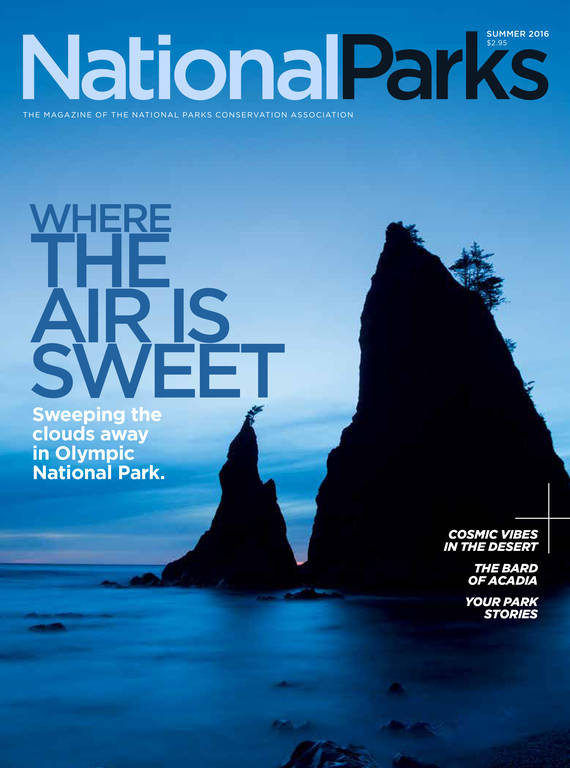Summer 2016
Founding Mother
Welcomed by former outcasts, an endangered seal starts a dynasty at Kalaupapa National Historical Park.
At first she was just a young seal swimming alone in unfamiliar waters. When she came ashore onto an empty beach on the island of Molokai, scientists assigned her a number, R006. Later, she gave birth to a pup on that beach, part of Kalaupapa National Historical Park. No seal had done that in recorded history, and it earned her a new name: Mama Eve.
Mama Eve doesn’t look like much. If you saw her asleep on the beach, you’d be forgiven for mistaking her for a big rock, or a 450-pound lump of gray jelly. Her body’s covered in so many scars and shark bites that scientists don’t need to tag her to tell her apart from other seals. But for the population of Hawaiian monk seals, one of the world’s most endangered marine mammals, Mama Eve is a ray of hope — the dynasty she’s created at Kalaupapa is helping keep her species alive.
Only about 1,300 Hawaiian monk seals are left, and though the population has been relatively stable recently, it has historically declined at a rate of 4 percent a year. About 1,100 live in the remote Northwestern Hawaiian Islands, where discarded nets and other marine debris, shark attacks and beach loss contribute to an 80 percent mortality rate among pups. The 200 or so seals that live on the main islands vie for space on crowded beaches. They’re also vulnerable to disease and, in a few documented cases, intentional killings. The Hawaiian monk seal’s two closest relatives have fared even worse: Fewer than 700 Mediterranean monk seals hang on between Madeira and the Aegean Sea, while the last Caribbean monk seal was seen in the 1950s.
With survival rates down and the population at a critical juncture, R006’s discovery of ‘Īlio pi'i beach in 1997 presented a rare opportunity. Though seals hadn’t been seen there in decades, the shallow waters and offshore reefs made it an ideal place to raise pups. R006 gave birth to her first one soon after her arrival, and then to 13 more over the next 17 years. Her offspring eventually gave birth to 35 additional pups, all at Kalaupapa. Other seals learned of the safe pupping area and began to come to the beach year-round. In all, 92 monk seals — a significant chunk of the species’ remaining population — have been born on the beaches of Kalaupapa over the past two decades.
Unknown to Mama Eve, Kalaupapa was a symbolic stage for a comeback.
In 1865, to contain the spread of leprosy, or Hansen’s disease, King Kamehameha V signed a law mandating the isolation of all those afflicted. The first outcasts arrived on the Kalaupapa peninsula the following year. The setting was beautiful — with ocean on two sides and 2,000-foot-high sea cliffs on the third — but the residents were almost completely cut off from the rest of the world. More than 8,000 men and women lived and died at the colony until the state of Hawaii lifted the confinement laws in 1969. Kalaupapa National Historical Park was established in 1980 so that the National Park Service could preserve the history of the settlement.
Hawaiian monk seals may have used the beaches at Kalaupapa long ago. The name of the beach that Mama Eve first arrived at means “climbing dog” in Hawaiian, possibly a reference to the name for the seals themselves, īlio-holo-i-ka-uaua or “dog that runs in rough seas.” No records of seals pupping on the peninsula exist, but the potential was always there, said Thea Johanos-Kam, a research wildlife biologist with the National Oceanic and Atmospheric Administration, the federal agency responsible for managing the seals. “The shallow water and boulders near the beach protect pups from sharks,” she said, “and the reefs here are in better shape than on nearby islands, so there’s a local source of food.” What’s more, the isolation of the peninsula protects the seals from disturbances they would likely encounter on the main islands. That is still true today because of strict visitation rules — no one under 16 and no more than 100 visitors per day are permitted in the park.
A receptive local community has also contributed significantly to the success of Kalaupapa seals, said Eric Brown, a marine ecologist at Kalaupapa. Making room for the seals on the main islands can be complicated. Some local fishermen resent the protection of the seals, which they say pluck fish from their nets. Cohabitation along the shore is also a challenge: On beaches all over the main Hawaiian Islands, teams of volunteers with cones and caution tape cordon off seals to keep humans away, but that hasn’t solved the problem. And then there are the killings. Since 2009, at least nine seals have died under suspicious circumstances on the main Hawaiian Islands. Some have been found beaten to death; others have been shot.

National Parks
You can read this and other stories about history, nature, culture, art, conservation, travel, science and more in National Parks magazine. Your tax-deductible membership donation of $25 or more entitles…
See more ›At Kalaupapa, the mood is different. Brown said that eight years ago, when NOAA approached the remaining residents about releasing a rehabilitated pup in the park, they made it clear that any seals would be well received. “‘Bring ’em in!’ they said,” Brown recounted. “The residents wanted the peninsula to be known as a place where seals are welcomed and cherished.” Brown thinks the community’s acceptance of the seals is connected to its history. Leprosy patients sent to Kalaupapa “were outcasts, people who were forcibly separated from their families and loved ones,” he said. “They view the seals as more than just another endangered species. They are part of the family here.”
Mama Eve herself has not pupped at Kalaupapa since 2013, and she hasn’t been seen for a couple of years. It’s a little nerve-wracking, but Johanos-Kam is quick to point out that it doesn’t mean that she’s died. “There are a lot of places she could be,” she said.
This spring, four baby seals made their debut at Kalaupapa. Two of those pups have the seal equivalent of royal blood — they are Mama Eve’s great-granddaughters. Even though the matriarch of the island may never touch these shores again, her dynasty lives on.
About the author
-
 Nicholas Lund Former Senior Manager, Landscape Conservation Program
Nicholas Lund Former Senior Manager, Landscape Conservation ProgramNick is a nature writer whose writing on birds and nature has appeared in Audubon magazine, Slate.com, The Washington Post and more. His most recent book is "Dinosaurs to Chickens: How Evolution Works." He lives in Maine with his wife and son and works for Maine Audubon.



